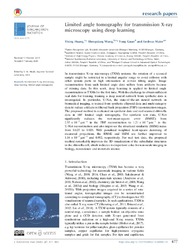Limited angle tomography for transmission X-ray microscopy using deep learning
DOI: https://doi.org/10.1107/S160057752000017X
Persistent URL: http://resolver.sub.uni-goettingen.de/purl?gldocs-11858/9467
Persistent URL: http://resolver.sub.uni-goettingen.de/purl?gldocs-11858/9467
Huang, Yixing; Wang, Shengxiang; Guan, Yong; Maier, Andreas, 2020: Limited angle tomography for transmission X-ray microscopy using deep learning. In: Journal of Synchrotron Radiation, Band 27, 2: 477 - 485, DOI: 10.1107/S160057752000017X.
 |
Dokument öffnen: |
In transmission X-ray microscopy (TXM) systems, the rotation of a scanned sample might be restricted to a limited angular range to avoid collision with other system parts or high attenuation at certain tilting angles. Image reconstruction from such limited angle data suffers from artifacts because of missing data. In this work, deep learning is applied to limited angle reconstruction in TXMs for the first time. With the challenge to obtain sufficient real data for training, training a deep neural network from synthetic data is investigated. In particular, U-Net, the state-of-the-art neural network in biomedical imaging, is trained from synthetic ellipsoid data and multi-category data to reduce artifacts in filtered back-projection (FBP) reconstruction images. The proposed method is evaluated on synthetic data and real scanned chlorella data in 100° limited angle tomography. For synthetic test data, U-Net significantly reduces the root-mean-square error (RMSE) from 2.55 × 10−3 µm−1 in the FBP reconstruction to 1.21 × 10−3 µm−1 in the U-Net reconstruction and also improves the structural similarity (SSIM) index from 0.625 to 0.920. With penalized weighted least-square denoising of measured projections, the RMSE and SSIM are further improved to 1.16 × 10−3 µm−1 and 0.932, respectively. For real test data, the proposed method remarkably improves the 3D visualization of the subcellular structures in the chlorella cell, which indicates its important value for nanoscale imaging in biology, nanoscience and materials science.
Statistik:
ZugriffsstatistikSammlung:
This is an open access article under the terms of the Creative Commons Attribution License, which permits use,
distribution and reproduction in any medium, provided the original work is properly cited.

